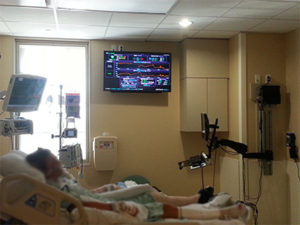By Bryan Haardt
In his first few weeks in office, President Trump has very quickly put into action many of the promises he made on the campaign trail. This has many hospitals wondering what their future looks like, if major changes to the health care system are in fact underway. From a design and construction perspective, this may not have too much of an impact on any plans for growth (either pending or in progress) that hospitals may already have; one of the promises in the President’s inauguration speech was to improve the country’s infrastructure, including its hospitals. Following the Affordable Care Act (ACA) measure to tie Medicare funding to patient satisfaction, hospitals had already started investing in making improvements to the patient experience through new construction, hospital expansions, upgraded equipment, improved technology, and more. Even if the measure that prompted these moves changes due to the new administration, it seems as though the emphasis on making them likely will not.

Photo Credit: Courtesy of Decisio
But with the ACA in jeopardy, the industry is facing regulatory uncertainty. The question that remains, then, is how a hospital’s infrastructure will support potential changes to health care policies and processes. Should we modify plans, or put them on hold, until we know more about what’s to come?
The answer is no — as long as you’ve got the right technology in place. The current unpredictability underscores the critical need for hospitals to develop more flexible, agile infrastructures that can support any kind of change. Sure, the political climate is unlike any we’ve seen in quite a while. But that doesn’t change the fact that parties in power change in our country on a regular basis — whether it’s four years or eight, whether the change is minor or more extreme. Rather than dealing in hypotheticals and trying to determine where recent political changes will take the health care industry, hospitals must invest in sustainable technology that will be able to handle any changes down the line. Regardless of who’s in office, the health care industry needs to remain focused on technological innovation.
More specifically, hospitals caught in this political tug-of-war should be looking at technology solutions that will help them easily and rapidly deploy sweeping changes to processes and protocols, without any extra cost or time delay. The challenge of being able to do this seamlessly has been brought to light for many hospitals recently, as they begin to see that the multi-billion dollar investment made in Electronic Health Records (EHRs) in the last few years has been somewhat lacking in terms of ROI. “Easy” and “rapid” aren’t words anyone would use to describe EHRs, employed not only for their intended purpose but also for analytics and reporting to help meet CMS requirements and improve care. Unfortunately, EHRs weren’t designed with the future of regulations or ease of innovation in mind.
With EHRs, the cost to adapt is just too high. Typically, when a change is made to the EHR, hospitals have to pay for it; not only financially, as an added customization from the EHR vendor or a third-party consultant, but also in time spent — up to several months to see a change implemented. For example, there are some hospitals in the U.S. that just recently got Ebola alerts activated in their EHR systems — well after the time of need. It will now take another nine months for those alerts to be deactivated.
On the local level, the state of Illinois recently mandated new protocols regarding sepsis diagnosis and treatment. That’s a change that hospitals around the state may not have planned for in advance, yet the right infrastructure would allow them to respond to it quickly — without waiting months or even years to see the new protocols deployed.
So what can hospitals put in place to ensure they can support whatever change may come its way? Health care is an industry in which change is inevitable, whether due to a new administration, a global disease epidemic, state legislature, or even patient demand. Because of that, EHR systems alone are not the solution; think of them more as an electronic filing cabinet, or an operating system upon which other technologies can be built.
To be ready for change, it’s time for the health care industry to course-correct on EHR investments, and build infrastructure instead on technologies that are nimble and don’t require major added costs to rollout system changes based on government regulation.
The good news? Technology is already a key element of hospitals’ design and construction plans. A 2015 study by Premier found that the biggest investment for hospital expenditures is on health information technology, according to 72.2 percent of respondents.
Hospitals looking to expand or break ground have the opportunity to make smart investments in flexible technology that will adapt to any regulatory changes that might come about in the next year, and continue to meet the changing tide of patient demand. Instead of trying to determine where political change will take the medical community and when, these hospitals need to prepare by investing in flexible technology systems that can handle changes down the line seamlessly.
Bryan Haardt is the CEO of Decisio Health, based in Houston.






